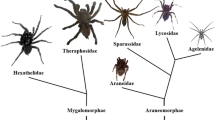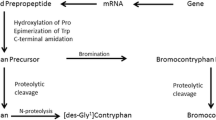Abstract
Molluscs of the genus Conus (cone shells) are carnivorous, feeding on marine worms, small fish and other marine molluscs. They capture their prey by injecting venom containing hundreds of neurally active peptide components. These peptides are classed as conotoxins and consist of small disulfide-bonded peptides exhibiting a high degree of post-translational modifications (PTMs). The functional roles of these modifications remain largely unknown. Two of the most frequently observed modifications are γ-carboxylation of glutamate and hydroxylation of proline (Buczek et al. Cell Mol Life Sci 62:3067, 2005). Vc1.1 is an α-conotoxin from Conus victoriae (Sandall et al. Biochemistry 42(22):6904–6911, 2003) and the only form of this peptide which has been detected in the venom is the γ-glutamate and hydroxyproline (Vc1.1.P6O:E14Gla) version of the molecule (Jakubowski et al. Toxicon 47(6):688–699, 2006). In order to investigate the role of PTMs, we did mass spectral profiling of the venom duct of C. victoriae looking at changes in mass and the number of peptides detected. We synthesised a number of predicted Vc1.1-PTM peptides together with the three possible disulfide isoforms of Vc1.1 and assessed the possible functional role of the PTM conopeptides by measuring the in vitro activity at the cognate neuronal nicotinic acetylcholine receptors (nAChRs). In addition we looked for their presence Vc1.1 venom by mass spectrometry and by this approach we were able to detect unmodified Vc1.1 in C. victoriae venom for the first time.








Similar content being viewed by others
References
Balaji RA, Ohtake A, Sato K, Gopalakrishnakone P, Kini RM, Seow KT, Bay BH (2000) lambda-conotoxins, a new family of conotoxins with unique disulfide pattern and protein folding. Isolation and characterization from the venom of Conus marmoreus. J Biol Chem 275(50):39516–39522
Bingham J, Jones A, Alewood PF, Lewis RJ (1996) Conus venom peptides (Conopeptides): inter-species, intra-species and within individual variation revealed by ionspray mass spectrometry. In: Lazarovici P, Spira ME, Zlotkin E (eds) Biochemical aspects of marine pharmacology. Alaken Inc., Colorado, pp 13–27
Brown MA, Begley GS, Czerwiec E, Stenberg LM, Jacobs M, Kalume DE, Roepstorff P, Stenflo J, Furie BC, Furie B (2005) Precursors of novel Gla-containing conotoxins contain a carboxy-terminal recognition site that directs gamma-carboxylation. Biochemistry 44(25):9150–9159
Buczek O, Bulaj G, Olivera BM (2005) Conotoxins and the posttranslational modification of secreted gene products. Cell Mol Life Sci 62:3067–3079
Bulaj G, Olivera BM (2008) Folding of conotoxins: formation of the native disulfide bridges during chemical synthesis and biosynthesis of Conus peptides. Antioxid Redox Signal 10(1):141–155
Clark RJ, Fischer H, Nevin ST, Adams DJ, Craik DJ (2006) The synthesis, structural characterization, and receptor specificity of the alpha-conotoxin Vc1.1. J Biol Chem 281(32):23254–23263
Dutton JL, Bansal PS, Hogg RC, Adams DJ, Alewood PF, Craik DJ (2002) A new level of conotoxin diversity, a non-native disulfide bond connectivity in alpha-conotoxin AuIB reduces structural definition but increases biological activity. J Biol Chem 277(50):48849–48857
Ellison M, Olivera BM (2007) “Alpha4/3 conotoxins: phylogenetic distribution, functional properties, and structure-function insights.”. Chem Rec 7(6):341–353
Flecker H (1936) Cone shell mollusc poisoning, with report of a fatal case. Med J Aust 4:464–466
Fletcher JM, Hughes RA (2004) A novel regioselective synthesis of a disulfide-linked heterodimeric bicyclic peptide mimetic of brain-derived neurotrophic factor. Tetrahedron Lett 45:6999–7001
Gehrmann J, Alewood PF, Craik DJ (1998) Structure determination of the three disulfide bond isomers of alpha-conotoxin GI: a model for the role of disulfide bonds in structural stability. J Mol Biol 278(2):401–415
Hill JM, Oomen CJ, Miranda LP, Bingham JP, Alewood PF, Craik DJ (1998) Three-dimensional solution structure of alpha-conotoxin MII by NMR spectroscopy: effects of solution environment on helicity. Biochemistry 37(45):15621–15630
Hu SH, Loughnan M, Miller R, Weeks CM, Blessing RH, Alewood PF, Lewis RJ, Martin JL (1998) The 1.1 A resolution crystal structure of [Tyr15]EpI, a novel alpha-conotoxin from Conus episcopatus, solved by direct methods. Biochemistry 37(33):11425–11433
Jakubowski JA, Kelley WP, Sweedler JV (2006) Screening for post-translational modifications in conotoxins using liquid chromatography/mass spectrometry: an important component of conotoxin discovery. Toxicon 47(6):688–699
Jepson JE, Brown LA, Sattelle DB (2006) The actions of the neonicotinoid imidacloprid on cholinergic neurons of Drosophila melanogaster. Invert Neurosci 6(1):33–40
Le Novere N, Corringer PJ, Changeux JP (2002) The diversity of subunit composition in nAChRs: evolutionary origins, physiologic and pharmacologic consequences. J Neurobiol 53(4):447–456
Livett BG, Mitchelli KI, Dean KM (1987) Adrenal chromaffin cells—their isolation and culture. In: Poisner AM, Trifaro JM (eds) In vitro methods for studying secretion. Elsevier, Amsterdam, pp 171–175
Lopez-Vera E, Walewska A, Skalicky JJ, Olivera BM, Bulaj G (2008) Role of hydroxyprolines in the in vitro oxidative folding and biological activity of conotoxins. Biochemistry 47(6):1741–1751
Loughnan ML, Nicke A, Jones A, Adams DJ, Alewood PF, Lewis RJ (2004) Chemical and functional identification and characterization of novel sulfated alpha-conotoxins from the cone snail Conus anemone. J Med Chem 47(5):1234–1241
Marshall J, Kelley WP, Rubakhin SS, Bingham JP, Sweedler JV, Gilly WF (2002) Anatomical correlates of venom production in Conus californicus. Biol Bull 203(1):27–41
McIntosh JM, Corpuz GO, Layer RT, Garrett JE, Wagstaff JD, Bulaj G, Vyazovkina A, Yoshikami D, Cruz LJ, Olivera BM (2000) Isolation and characterization of a novel Conus peptide with apparent antinociceptive activity. J Biol Chem 275(42):32391–32397
Nelson L (2004) “One slip and you’re dead”. Nature 429:798–799
Nicke A, Samochocki M, Loughnan ML, Bansal PS, Maelicke A, Lewis RJ (2004) “Alpha-conotoxins EpI and AuIB switch subtype selectivity and activity in native versus recombinant nicotinic acetylcholine receptors”. FEBS Lett 554(1–2):219–223 (Erratum in: FEBS Lett 557(1–3): 294)
Olivera BM, Rivier J, Clark C, Ramilo CA, Corpuz GP, Abogadie FC, Mena EE, Woodward SR, Hillyard DR, Cruz LJ (1990) Diversity of Conus neuropeptides. Science 249(4966):257–263
Quiram PA, McIntosh JM, Sine SM (2000) Pairwise interactions between neuronal alpha(7) acetylcholine receptors and alpha-conotoxin PnIB. J Biol Chem 275(7):4889–4896
Rice RD, Halstead BW (1968) Report of fatal cone shell sting by Conus geographus Linnaeus. Toxicon 5(3):223–224
Röckel D, Korn W, Kohn A (1995) Manual of the living conidae, vol 1. Indo-Pacific Region, Verlag Christa Hemmen, Weisbaden, Germany (ISBN 3-925919-09-0)
Sandall DW, Satkunanathan N, Keays DA, Polidano MA, Liping X, Pham V, Down JG, Khalil Z, Livett BG, Gayler KR (2003) A novel alpha-conotoxin identified by gene sequencing is active in suppressing the vascular response to selective stimulation of sensory nerves in vivo. Biochemistry 42(22):6904–6911
Satkunanathan N, Livett B, Gayler K, Sandall D, Down J, Khalil Z (2005) “Alpha-conotoxin Vc1.1 alleviates neuropathic pain and accelerates functional recovery of injured neurones”. Brain Res 1059(2):149–158
Sharpe IA, Gehrmann J, Loughnan ML, Thomas L, Adams DA, Atkins A, Palant E, Craik DJ, Adams DJ, Alewood PF, Lewis RJ (2001) Two new classes of conopeptides inhibit the alpha1-adrenoceptor and noradrenaline transporter. Nat Neurosci 4(9):902–907
Shon KJ, Koerber SC, Rivier JE, Olivera BM, McIntosh JM (1997) Three-dimensional solution structure of alpha-conotoxin MII, an alpha3beta2 neuronal nicotinic acetylcholine receptor-targeted ligand. Biochemistry 36(50):15693–15700
Towers PR, Sattelle DB (2002) A Drosophila melanogaster cell line (S2) facilitates post-genome functional analysis of receptors and ion channels. Bioessays 24(11):1066–1073
Zhang RM, Snyder GH (1991) Factors governing selective formation of specific disulfides in synthetic variants of alpha-conotoxin. Biochemistry 30(47):11343–11348
Acknowledgments
We thank Dr. Jennifer Jakubowski for their advice on optimisation of mass spectral conditions for conopeptides. Thanks also to Dr. Robyn Bradbury for provision of the C. victoriae specimens, and to Mr John Ahern of the Department of Zoology, University of Melbourne, for maintaining the snails in captivity. We thank Dr. Tom Hennessy from Agilent for software analysis.
Author information
Authors and Affiliations
Corresponding author
Rights and permissions
About this article
Cite this article
Townsend, A., Livett, B.G., Bingham, JP. et al. Mass Spectral Identification of Vc1.1 and Differential Distribution of Conopeptides in the Venom Duct of Conus victoriae. Effect of Post-Translational Modifications and Disulfide Isomerisation on Bioactivity. Int J Pept Res Ther 15, 195–203 (2009). https://doi.org/10.1007/s10989-009-9173-4
Received:
Accepted:
Published:
Issue Date:
DOI: https://doi.org/10.1007/s10989-009-9173-4




